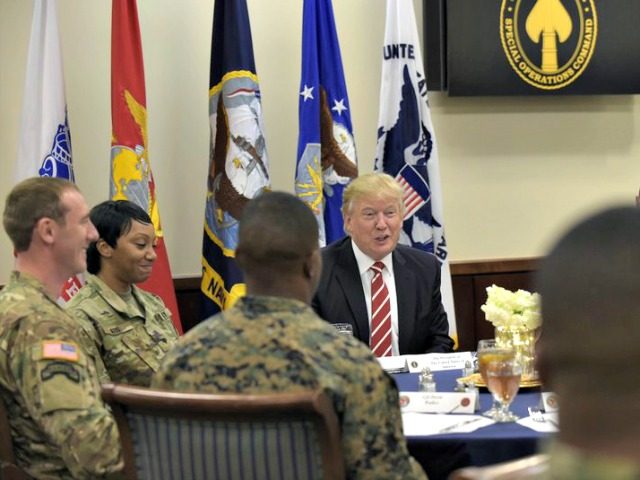President Trump’s proposed budget would boost spending on the military and veterans services in 2018, while cutting back on non-defense spending.
It would boost defense spending by 10 percent over the current 2017 enacted level, and veterans affairs spending by 5.9 percent, according to a White House blueprint released Thursday.
“The budget for [the Department of Defense] ends the depletion of our military and pursues peace through strength, honoring the Federal Government’s first responsibility: to protect the Nation,” it said.
Specifically, the president has proposed $603 billion in total defense spending, which includes funding for the Pentagon and defense funding in other agencies, such as the Department of Energy.
It proposes $574 billion for the Pentagon’s base budget — $19 billion more than what President Obama projected for 2018.
In addition to the $603 billion, the administration has proposed $65 billion in war costs — the same as the current 2017 amount.
The blueprint notes that instead of spending more on war — which it says consumes resources — the administration will “invest in a stronger military.”
The budget emphasizes rebuilding warfighting readiness, after 15 years of war.
Specifically it mentions rebuilding stocks of critical munitions, and dealing with personnel gaps, deferred maintenance and modernization, cyber vulnerabilities, and degraded facilities.
It also mentions spending more on training, equipment and infrastructure.
Those things highlight the budget’s emphasis on rebuilding the military versus just expanding it.
Indeed, the blueprint states: “The military must reset war losses, address recapitalization and maintenance requirements, and recover from years of deferred investment forced by budget cuts.”
“Those are really aimed at improving the current readiness of the military — so making sure the forces that we have today are actually prepared to go out and fight if they’re called upon,” said Todd Harrison, director of the Aerospace Security Project and Defense Budget at the Center for Strategic and International Studies.
The budget plan also pledges to grow the military — or at least reverse trends in reductions of forces begun under the Obama administration.
Specifically, it would reverse troop cuts in the Army and increase the total number of ships in the Navy.
It also pledges to spend more on training and equipment for the Marine Corps, and on future superiority for the Air Force.
Harrison says there is a risk in growing the size of the military without a long-term budget agreement, since it will only cost more to maintain.
He said with more forces, the budget will need to grow, but that “doesn’t necessarily mean that Congress will have the political ability to continue increasing the budget.”
“To quote ‘Top Gun,’ we’re writing checks that we won’t be necessarily able to cash,” he said.
The balance between restoring readiness and growing more forces won’t be clear until the administration formally releases its 2018 budget proposal, expected in May.
And it’s also not clear if Trump’s proposal will survive contact with Congress.
Defense hawks on the Hill want a larger defense budget, and Democrats are angered by $54 billion in proposed cuts to non-defense spending.
Any 2018 defense budget would need 60 votes in the Senate — including all Republicans and eight Democrats.
It’s also $54 billion more than what is allowed under budget caps set by the 2011 Budget Control Act, which kicked in when lawmakers failed to reach tax and spending reform. Congress would need to lift those caps.
“It’s a long way from being a done deal…there’s going to be a big fight in Congress over this,” said Harrison. “They need a compromise, and this proposal is not a compromise.”
For the Department of Veterans Affairs, Trump’s budget requests $4.4 billion above the current 2017 level, or a six percent increase.
The blueprint says it would extend and fund the Veterans Choice Program, which allows veterans to seek care through a private provider closer to home.
It also says it would support VA programs for homeless and at-risk veterans and their families; provide access to education benefits, enhanced services, and other programs to assist veterans’ transition to civilian life; and continue critical investments in improving the VA’s claims processes.
It will also invest in information technology to improve the efficiency and efficacy of VA services, and provides “sufficient funding” for initiatives for modernizing the VA and avoids the costs of “maintaining outdated, inefficient systems.”
The plan got an early endorsement from Veterans of Foreign Wars, the nation’s largest and oldest major war veterans organization. VFW Commander-in-Chief Brian Duffy said:
“The VFW is pleased that President [Donald] Trump has lived up to his campaign promises to relieve our nation’s military from the budget ax called sequestration, sustain our all-volunteer force, and provide for the needs of our veterans, but more work lies ahead for this administration to rebuild trust and confidence in our nation’s veterans programs, as well as improve the readiness and morale of our military.
“Unfortunately, years of sequestration and short-sighted budget battles in Congress have left our service members without the resources and training it needs to protect our nation’s interests, and we’ve seen over and over again how penny-pinching in the budget for the Department of Veterans Affairs has left veterans waiting far too long for the health care and benefits they have rightfully earned,” he said.

COMMENTS
Please let us know if you're having issues with commenting.